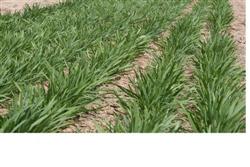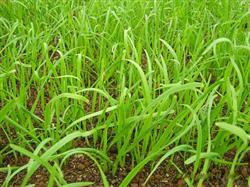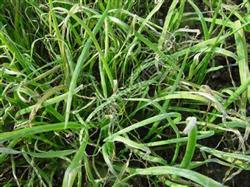High-yielding cultivation techniques of winter leek in Hanzhong

Hanzhong winter leek is a leading leek variety in Hanzhong, Shaanxi Province, with large leaves, sturdy pseudostems, more tillers, high yield, strong cold tolerance and short dormancy period. it is suitable for cultivation in open field and protected field in the north, and can be listed all the year round. Winter leek is rich in nutrition, high carotene content, light spicy taste and less fiber, so it is deeply welcomed by consumers. Now its high-yield and high-quality cultivation techniques are introduced as follows for vegetable farmers' reference. 1. Cultivate strong seedlings, ①, select and prepare land. Select the land which is loose and fertile, convenient for drainage and irrigation, and has not planted onion and garlic vegetables for 3 years. After the harvest of the previous crop, apply high-quality organic fertilizer 3000mu to 3500kg, ternary compound fertilizer 50kg, ploughing fine Harrow, and form a flat border 1.5 meters wide. ② is suitable for sowing. From late March to early April, when the local temperature stably passes through 12 ℃, the seedlings can be sowed and raised. ③ seed treatment. Generally, about 5 kilograms of seeds are needed per mu. Dry the seeds for 2-3 days before sowing, soak the seeds in 40 ℃ warm water for 24 hours, remove, wash and drain, wrap them in a wet cloth and accelerate germination at 20-25 ℃. When 80% of the seeds are white, they can be sown. ④ sowing method. Pour enough bottom water before sowing, sprinkle a thin layer of fine soil before sowing, to prevent the seeds from getting muddy, then evenly sow the seeds into the seedling bed and cover the fine soil 1.5 cm thick, and then cover the fine soil 1 cm thick the next day to facilitate seedling emergence. ⑤ seedbed management. After emergence, keep the soil moist. When the seedlings grow to 4 cm high, water them every 5 to 6 days; when the seedlings grow to 8 cm high, apply urea 8 kg / mu with water; squat seedlings when they reach 12 cm high, control up and down, and cultivate strong seedlings with multiple tillers. At the same time, we should do a good job in the prevention and control of diseases, insect pests and weeds. two。 Colonization time of ①. When the leek seedlings grow to 15-18 cm high with 1-2 tillers, the planting should not be later than the first ten days of July. ② soil preparation and fertilization. After the previous harvest, 4000kg / mu of high-quality organic fertilizer, 60kg of ternary compound fertilizer, deep ploughing and fine raking were applied to form a flat bed 1.5 to 1.8 meters wide. ③ reasonable close planting. Generally, it is planted according to the specifications of row spacing 25 cm 30 cm and plant spacing 15 cm 20 cm. About 5 seedlings are planted in each hole and 12000 holes are guaranteed per mu. ④ planting method. The seedlings should be planted as they rise. After rising, the first end of the fibrous root will be cut off, leaving only 2-3 cm, and then cut off a section of the leaf to reduce leaf evaporation, and then dig holes or trench planting on the border according to the plant spacing. The bulbs of leek seedlings planted in each hole should be neat and compact between plants. When cultivating the soil, the top of the bulb can be buried in the soil 3-4 cm deep (too deep to grow, too shallow to jump root too fast), and compacted with soil around. Water immediately after planting to slow down the seedlings. 3. Daejeon manages ① to top fertilizer in time. When leek seedlings grow new leaves and roots, urea 20kg / mu is applied. In the middle of August, 200 kg of cake fertilizer or 1000-1500 kg of rotten organic fertilizer was applied per mu. In the middle of September, 2530kg of urea or 30kg of ternary compound fertilizer was applied per mu. In winter or early spring of the following year, in order to increase the soil temperature and promote sprouting, the rotten organic fertilizer was applied to 3000-5000 kg per mu, and after the new buds were unearthed, human and animal manure was watered again. After every harvest, urea was applied 20,25kg per mu. ② scientific management of water. Leek should avoid waterlogging and be afraid of dampness. Drainage should be carried out in time after rain, and the soil should be kept dry and wet at ordinary times. Water immediately after fertilizing. Two to three days after harvest, water was watered once with fertilization. Before freezing, the soil should be watered once to facilitate overwintering and bud germination in the following spring. ③ ploughing and weeding. After transplanting, one shallow ploughing was carried out. Ploughing and soil cultivation was carried out once after harvest and fertilization. Ploughing and draining moisture as appropriate after rain. 4. Diseases, pests and weeds were used to control ① diseases. There are mainly downy mildew, gray mildew, blight and so on. Carbendazim, aluminophosphate, metalaxyl, oxazole, frost urea cyanide and manganese zinc can be used for control. ② pest. There are chive maggot, thrips, Plutella xylostella, leaf miner and so on, which can be controlled by phoxim, imidacloprid and pyrethroid. ③ weeds. 50% Acetochlor can be used before bud, and 48% trifluralin and other herbicides can be used at seedling stage. 5. Harvest ① harvest season. The leaves grow vigorously in spring, which is the main harvest time; the summer is high temperature and rainy, the quality becomes worse, and most of them are not harvested; in autumn, the leaves grow vigorously again and enter the harvest period. About 30 days before the leek withered, the harvest should be stopped to make it wither naturally, and the nutrition should be transferred to the root to lay a good foundation for the robust growth of leek in the next spring. If protected cultivation is implemented, it can also be supplied to the market in winter. The number of ② harvests. It is generally harvested 5-6 times a year, such as good fertilizer and water conditions and proper management, it can harvest 7-8 times. Generally, the yield per mu can reach 4000-5000 kg, and the high-yield field can reach more than 7000 kg. ③ harvesting method. When the seedling height is 35cm to 40cm, the harvest time is sunny morning, and the stubble is 2cm to 3cm high.
- Prev

Tips for dry sowing chives
1. Seed selection: according to local cultivation methods, cultivation purposes, climatic conditions, consumption habits and market demand, excellent leek varieties with marketable, disease and insect resistance, strong stress resistance and good commercial quality can be selected. The quality of seeds meets the requirements of GB8079. Refuse to use genetically modified leek varieties. 2. Seed treatment:.
- Next

Control of Botrytis cinerea of leek in greenhouse
Botrytis cinerea is easy to occur when the humidity is high in the leek greenhouse. After the onset of the disease, the leaves gradually produced grayish brown to white spots from the tip down, both positive and negative, oval or fusiform disease spots were enlarged, and fused into large dead spots. The air humidity is more than 85%, the temperature is 15 ℃ ~ 20 ℃, warm and humid strip.
Related
- Where is it suitable to grow horseradish in China? it is expected to see the middle altitude horseradish in Alishan.
- How to prevent tomato virus disease reasonably? (Control methods included)
- Many people like to plant towel gourd on the balcony. What are the main points of this method and management?
- What crops can chili peppers be mixed with?
- Fertilization techniques and matters needing attention in Tomato
- What are the grafting techniques for peach seedlings in spring?
- Harm and control methods of root swelling disease of Chinese cabbage
- What are the pests of sweet potatoes? How to prevent and cure it?
- Symptoms, causes and Control methods of navel Rot in Tomato
- The cause of "Cucumber rotten bibcock" in Farmers' planting Cucumber and its Control Plan

